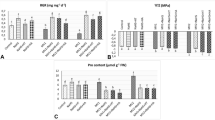Abstract
Bisulfite, a major form of SO2 in aqueous phase of apoplast, may reduce photosynthesis rate and thereby crop yield through inducing reactive oxygen species (ROS). In this study, ROS production was directly detected in a living cell of leaf of spinach (Spinacia oleracea L.) using laser scanning confocal microscopes with the assistance of the fluorescence probe dichlorofluorescin diacetate (H2DCF-DA). Results showed that, under bisulfite stress, a large quantity of ROS indicated by DCF fluorescence was produced in epidermic tissue. The role of plasma membrane (PM) NADPH oxidase in bisulfite-induced ROS production was also investigated. Treatment with bisulfite resulted in a significant increase in the content of ROS and the activity of PM NADPH oxidase in spinach leaves. The effects caused by bisulfite were inhibited pronouncedly by pretreatment with two widely used NADPH oxidase inhibitors (diphenyleneiodonium and quinacrine). Moreover, the change patterns of the bisulfite-induced increase and inhibitor-caused decrease in the two parameters were quite similar. Additionally, only a small amount of ROS could be observed on in vitro chloroplasts under bisulfite stress. Based on all the results, we conclude that ROS is involved in bisulfite-induced stress, and the bisulfite-induced enhancements in levels of ROS originate mainly from PM NADPH oxidase.
Similar content being viewed by others
References
R. B. Bressan, L. G. Wilson and P. Filner, Mechanisms of resistance to sulfur dioxide in the Cucurbitaceae Plant Physiol. 1978 61 761–767.
N. M. Darrall, The effect of air pollutants on physiological processes in plants Plant Cell Environ. 1989 12 1–30.
H. Pfanz and U. Heber, Buffer capacities of leaves, leaf cells, and leaf cell organelles in relation to fluxes of potentially acidic gases Plant Physiol. 1986 81 597–602.
U. Lüttge, C. B. Osmond, E. Ball, E. Brinckmann and G. Kinze, Bisulfite compounds as metabolic inhibitors: nonspecific effects on membranes Plant Cell Physiol. 1972 13 505–514.
H. Pfanz, E. Martinoia, L. Otto-Ludwig and U. Heber, Flux of SO2 into leaf cells and cellular acidification by SO2Plant Physiol. 1987 85 928–933.
H. Mehlhorn, G. Seufert, A. Schmidt and K. J. Kunert, Effect of SO2 and O3 on production of antioxidants in conifers Plant Physiol. 1986 82 336–338.
N. R. Madamanchi and R. G. Alscher, Metabolic bases for differences in sensitivity of two pea cultivars to sulfur dioxide Plant Physiol. 1991 97 88–93.
G. D. Peiser, C. C. Lizada and S. F. Shang, Sulfite-induced lipid peroxidation in chloroplasts as determined by ethane production Plant Physiol. 1982 70 994–998.
K. Apel and H. Hirt, Reactive oxygen species: metabolism, oxidative stress, and signal transduction Annu. Rev. Plant Biol. 2004 55 373–399.
D. Takemoto, A. Tanaka and B. Scott, A p67Phox-like regulator is recruited to control hyphal branching in a fungal-grass mutualistic symbiosis Plant Cell 2006 18 2807–2821.
A. Tanaka, M. J. Christensen, D. Takemoto, P. Park and B. Scott, Reactive oxygen species play a role in regulating a fungus-perennial ryegrass mutualistic interaction Plant Cell 2006 18 1052–1066.
R. Shin, R. H. Berg and D. P. Schachtman, Reactive oxygen species and roots hairs in Arabidopsis root response to nitrogen, phosphorus and potassium Deficiency Plant Cell Physiol. 2005 46 1350–1357.
R. Desikan, Man-kim Cheung, J. Bright, D. Heson, J. T. Hancock and S. J. Neill, ABA, hydrogen peroxide and nitric oxide signaling in stomatal guard cell J. Exp. Bot. 2003 55 205–212.
J. Forman, V. Demidchik and J. H. Bothwell, Reactive oxygen species produced by NADPH oxidase regulate plant cell growth Nature 2003 27 422–446.
M. Sagi and R. Fluhr, Production of reactive oxygen species by plant NADPH oxidase Plant Physiol. 2006 141 336–340.
R. G. Jensen and J. A. Bassham, Photosynthesis by isolated chloroplasts Proc. Natl. Acad. Sci. U. S. A. 1966 56 1095–1101.
U. Heber and K. A. Santarius, Direct and indirect transport of ATP and ADP across the chloroplast envelope Z. Naturforsch. 1970 25 718–728.
Ki-Youb Park, Ji-Yul Jung, J. Park, Jae-Ung Hwang, Yong-Woo Kim, I. Hwang and Y. Lee, A role for phosphatidylinositol 3-phosphate in abscisic acid-induced reactive oxygen species generation in guard cells Plant Physiol. 2003 132 92–98.
J. E. Benna, J. M. Ruedi and B. M. Babior, Cytosolic guanine nucleotide-binding protein rac2 operates in vivo as a component of the neutrophil respiratory burst oxidase J. Biol. Chem. 1994 269 6729–6734.
T. Xing, V. J. Higgins and E. Blumwald, Race-specific elicitors of Cladosporium fulvum promote translocation of cytosolic components of NADPH oxidase to the plasma membrane of tomato cells Plant Cell 1997 9 249–259.
C. A. Andrew and F. Robert, Two distinct sources of elicited reactive oxygen species in tobacco epidermal cells Plant Cell 1997 9 1559–1572.
E. Olmos, J. R. Martinez-Solano, A. Piqueras and E. Hellin, Early steps in the oxidative burst induced by cadmium in cultured tobacco cells (BY-2 line) J. Exp. Bot. 2003 54 291–301.
P. V. Gestelen, H. Asard and R. J. Caubergs, Solubilization and separation of a plant plasma membrane NADPH, synthase from other NAD(P)H oOxidoreductases Plant Physiol. 1997 115 543–550.
G. P. Bowlwell, D. R. Davies, C. Gerrish, Chung-Kyoon Auh and T. M. Murphy, Comparative biochemistry of the oxidative burst produced by rose and french bean cells reveals two distinct mechanisms Plant Physiol. 1998 116 1379–1385.
I. Boldogh, A. Bacsi, B. K. Chouchury, N. Dharajiya, R. Alam, T. K. Hazra, S. Mitra, R. M. Goldblum and S. Sur, ROS generated by pollen NADPH oxidase provide a signal that augments antigeninduced allergic airway inflammation J. Clin. Invest. 2005 115 2169–2179.
R. Cathcart, E. Schwiers and B. N. Ames, Detection of picomole levels of hydroperoxides using a fluorescent dichlorofluorescein assay Anal. Biochem. 1983 134 111–116.
Author information
Authors and Affiliations
Corresponding author
Rights and permissions
About this article
Cite this article
Li, B., Xing, D. & Zhang, L. Involvement of NADPH oxidase in sulfur dioxide-induced oxidative stress in plant cells. Photochem Photobiol Sci 6, 628–634 (2007). https://doi.org/10.1039/b618041h
Received:
Accepted:
Published:
Issue Date:
DOI: https://doi.org/10.1039/b618041h



